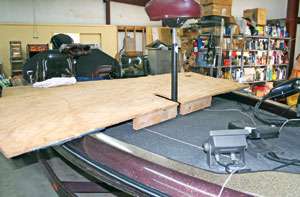
CONROE, Texas — The most common way to place artificial habitat inside your favorite fishery is to ask to borrow someone's pontoon boat and hope for the best.
Mike Schneider, an avid bass fisherman who lives on Lake Conroe in southeast Texas, did that for several years. But Schneider decided there had to be a better way.
Initially, he considered placing a heavy tarp over the front deck of his bass boat. But the chance of scratching the finish through an errant branch or piece of iron used for weights was just too great.
Why not build an extension deck for the front of his boat, he thought, one that he could easily install and remove? So he started sketching some basic plans and eventually created a workable brush-hauling buggy.
"Essentially, you build a frame that sits on top of the front of your boat that will not slip, slide around or come off when moving across the water," explained Schneider.
On his 21-foot bass boat, he uses two sheets (3/8 inch) of marine-grade plywood. One piece is 4 x 8 feet; the other is 2 x 8 feet. The two pieces are laid side by side with the long sides extending over the sides of the boat. This arrangement allows ready access to his trolling motor and depthfinder on the front of the boat.
Taking the 4- x 8-feet sheet, he first measures the distance from gunnel to gunnel in several locations where the plywood will rest. He then cuts several 2 x 4 stringers using these length measurements. Next, he attaches the stringers to the underside of the hauling platform with wood screws.
The stringers provide a snug fit when he lays the hauling platform atop the deck of his boat. These supports ensure the structure doesn't sag when he begins hauling material. The stringers come out to 24-inch centers. On different sized decks, the centers could be different.
"On my boat, 2 x 4s worked perfectly. On some boats, where the gunnels are not as tall, you might have to use 2 x 2s."
On the plywood side with the stringers, he glues indoor/outdoor carpet where the deck lays on the gunnels to prevent damage to the fiberglass.
The stringer that faces the forward piece of plywood (2 x 8 feet) is left with 1 inch uncovered. Thus, when he lays down the second sheet of plywood decking, one side of the decking will lay over the remaining 1 inch of the exposed stringer.
Now, using the 2- x 8-feet sheet of plywood, he again attaches stringers measured for the width of the boat where that plywood sheet will be positioned. He then measures where the pedestal for his front seat will fall on the plywood deck and cuts out a wide enough notch so that the deck can be laid down, notched in the right place for the seat pedestal.
On each side on the front deck of his boat, he uses tie-downs that secure rods to the deck. Using the eyelets, he cuts rope or cord to lengths long enough that they can be threaded from one eyelet to the other and then can be looped over the top of the decking when installed. Finally, he sinks three screws into the front sheet where it lays over the exposed forward stringer.
"Zip, zip and you have a front deck for hauling brush. You can load brush and it doesn't scratch up your bass boat. The whole thing is easy to put on or take off. To remove, untie the cords, back out the three screws and lift the decks off."
| For more great stories and the latest bass fishing news, subscribe to BASS Times. Call 877-BASS-USA to order today. |





